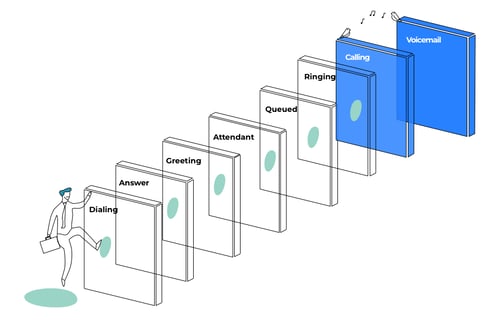I was delighted to see this article by David Pierce from the Wall Street Journal of July 2018. He shares many of our thoughts on the purported death of phone calling.
Clearly, Pierce has it right when he points out that the Internet and smart phones brought us ways to communicate -- email, text, Facetime, Instagram, Snapchat, chat bots, etc. -- "that make phone calls seem wildly inefficient." He's also right when he says that these methods lack the "warmth and humanity that made the telephone work in the first place.”
But we have to disagree with his suggestion for best alternative -- push to talk voice chat. Essentially a modern walkie-talkie solution, PTT is 30-year-old-tech, long on lineage but short on benefit. Don’t get me wrong: Voice Chat certainly has its place in specific use cases. But there is no replacement for real-time, two-way communications. And if you can make it a video call, it gets even better.
We all love to talk, but hate to call.
Here, though, is where Pierce really nails it: "The problem with phone calls was never the talking. It was all the related complexities." These boil down to two categories of time-killers, he writes. The first is preliminary -- dialing, ringing, getting an answer, or at least as often, not. The second is what voice industry executive Bill Moore calls "social overhead" -- hellos, self identification, and small talk.

In a business context, these "complexities" get much worse. Think about the last time you had to dial an 800 number. You may have put it off because you knew it was going to be painful. You had to navigate the dreaded auto attendant, entering touch tones and sometimes listening to new prompts, and then often waiting on hold for an unknown amount of time. You heard “your call is important to us, please remain on the line,” ringing more hollow with every repetition. Often, your reward was a chance to leave a voice mail, with no idea how long you would have to wait for a call back. It’s 2018, there has got to be a better way.
WHAT IS VOICE CHAT?
Voice Chat is a way to make and receive voice calls over the Internet without using traditional telephone lines. It allows two or more people to have real-time conversations using a browser or app on a computer or mobile device. Voice Chat calls are VoIP calls and don't use traditional telephone services which are sometimes referred to as the PSTN.
How can a business adapt their communication systems to changing behaviors and preferences.
So the question for businesses -- and therefore us, at OnSIP -- is this: How do we preserve the warmth and immediacy of phone calling while eliminating the complexity? Answer: we give companies a modern communications system that seamlessly blends the old with the new.
For customers who want to receive calls the old-fashioned way, via 10-digit phone number, we have that covered. But for those who need the bumpy road to customer service/sales help smoothed, as it were, we have something we call InstaCall: a voice and video communication channel imbedded right in your web site, under each employees name and/or face. One click gets your callers from wanting to talk to actually engaging with you personally - without going through 'phone tree Purgatory.'
With OnSIP's InstaCall you can invite your caller, without ever leaving your website, to skip the auto attendant and be routed immediately to the expert who can help them. With our applet imbedded, your web sites comes alive with one click and can engage with your staff by both video and audio. No plug-ins, or downloads required. Your staff will know what page the customer is calling from and could have already told you what they are calling about. You are primed for a memorable interaction. Your staff can use the same apps to take calls from your website and toll free number, seamlessly blending the old with the new.
InstaCall: A Two-Way Line of Sight in Web-initiated Customer Calls
Visualize further: You can webify your employee directory and make it clickable. Now each member of your staff (at least the staff you want to face the customer) has an InstaCall link -- a direct line -- for the world (or the password-holding world) to see. And because OnSIP's whole system is cloud-based and configurable, we give you the tools to make sure those links never let your callers down -- a very different experience from dialing the 800 number atop the page.
A bit further still: InstaCall works in video as well as audio. If you really want to create customer relationships and establish trust, give callers the choice to see and be seen in any given call. Video breaks down the walls of anonymity. It gives both ends of a conversation much more to work with, interactively, and to remember by. It may accelerate the sales cycle to the next important, in-person step.
The crucial element here is caller choice: Callers can choose to call your phone numbers but many may look to engage with you via your website. On your end, today's growth of video calling has obligated workers to dress and groom themselves for work, even when they work remotely. It's a way your company can show that you value your customers' time ... enabling direct connection and skipping the traditional phone tree.
Want to learn more, here is another great post that outlines the benefits of using web based video calling in customer service.

